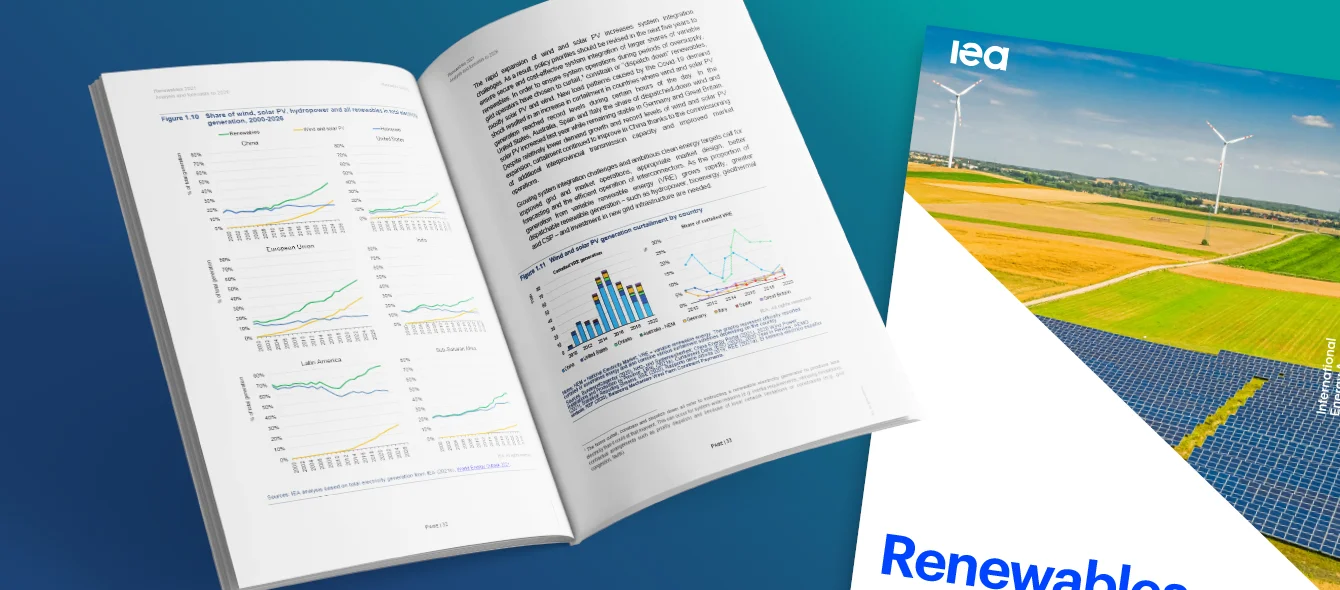Amid the global pandemic, 2020 was a record year for renewables, and 2021 looks set to top even that, according to the International Energy Agency (IEA). New renewable energy capacity additions worldwide are expected to reach almost 290 gigawatts this year.
Moreover, the agency’s report Renewables 2021: Analysis and forecast to 2026 shows that the groundwork has been laid for further exceptional growth over the next five years.
Clean energy additions dominate
One of the most extraordinary shifts of the last decade has been the now near complete dominance of renewable energy in new capacity additions. Renewables are expected to account for almost 95 percent of the increase in global power capacity through 2026, the IEA says.
Global renewable energy capacity is expected to grow by over 60 percent by 2026, reaching more than 4,800 gigawatts, equivalent to the current capacity of fossil fuel power generation and nuclear combined. China is adding clean energy generation fastest and will account for 43 percent of all additions, followed by Europe, the US and India. In total, these markets will account for 80 percent of the new capacity.
The IEA forecasts that both China and Europe will overshoot their current 2030 targets for renewable energy. The US is expected to see a 65 percent more rapid expansion in 2021-2026, compared with the preceding five-year period, while India’s deployment of renewables is accelerating in pursuit of its ambitious target of 500 gigawatts by 2030.
Solar power, both utility-scale and residential, will account for 60 percent of additions. Following a record 110 gigawatts globally for onshore wind in 2020, the IEA sees additions of 75 gigawatts on average a year through 2026. Offshore wind additions should reach 26 gigawatts in 2026, as the sector expands into new markets beyond Europe and China.
Europe to exceed targets
Europe is expected to add 300 gigawatts of new renewable energy capacity, mostly solar and wind. Three-quarters of this come from seven markets: Germany, Spain, France, the Netherlands, Turkey, the UK and Poland, creating thousand of jobs in the process.
Key drivers are government targets and government-held capacity auctions, as well as the growth of corporate power purchasing agreements as private sector companies implement their own sustainability goals.
By 2026, the IEA estimates that the EU’s renewable energy capacity will reach 750 gigawatts, with the rate of new additions at 40 gigawatts/year on average.
Expansion challenges
Dispatchable renewable energy – hydropower, geothermal and bioenergy – is forecast to account for only 11 percent of the new additions, owing to higher costs, weak policy support and limited remuneration of flexibility services, such as storage and demand-side management.
This threatens an imbalance between variable and dispatchable power generation, underlining the IEA’s concern over a lack of support for flexibility services, which facilitate the integration of more variable clean generation into national power systems.
In addition, raw materials and transport prices have risen sharply over the last year, pushing up the investment costs for solar and onshore wind by about 25 percent, the IEA says.
Many developers won competitive auctions based on the expectation of continuously falling prices. As a result, the current commodity price shock, if sustained, could result in the delay of 100 gigawatts of contracted capacity, the IEA warns.
Yet, solar and onshore wind remain the most competitive forms of power generation. For the moment, the IEA says, rising materials costs are being outweighed by stronger policy support from governments and the impetus created by new pledges made at the COP26 meeting held in early November in Scotland.
Policy priorities
The IEA notes that despite the urgency of climate change, renewables – including electricity, heat, biofuels and biogas – have received just 11 percent of governments’ economic recovery spending on clean energy.
The agency says that greater government spending could mobilise more than 400 billion dollars in total investment terms. In particular, the IEA says, biogas and biofuels would benefit from enhanced economic recovery stimulus plans.
Furthermore, as it and sectoral associations have both warned previously, slow permitting and grid integration remain barriers to expansion across almost all countries. In developing economies, policy inconsistency, lack of grid connections and financial risks are also damaging investor confidence.
If governments make a concerted effort to address these challenges in the next 12-24 months, the rate of renewable expansion could be 25 percent higher, the IEA estimates, reaching more than 380 gigawatts/year.
This would go some way to closing the gap between current policies and a worldwide trajectory for net zero emissions by 2050, which, the IEA says, would require 80 percent more renewable energy deployment in the period 2021-26 than currently forecast.
